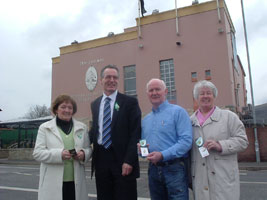20 March 2008 Edition
Sinn Féin promotes wearing of Easter Lily

Ann Murray, Gerry Kelly, Liam Shannon and Annie Cahill promoting the Easter Lily in Belfast last week
SINN FÉIN has made a major effort this year to promote the wearing of the Easter Lily to celebrate the memory of the 1916 Easter rising and to further popularise the cause of Irish unity. Last week the party’s four TDs and Senator Pearse Doherty launched a country-wide Easter Lily campaign. Over the Easter period, Sinn Féin activists are distributing more than 100,000 leaflets, while Easter commemorations will take place across the country.Martin Ferris TD and Senator Pearse Doherty recently wrote to all TDs and senators, encouraging them to wear the Lily this Easter.
The Easter Lily is an emblem of unity between the different traditions within the Irish nation as well as the heroism of those who sacrificed their lives in 1916. The Lily symbolises the possibility of unity, equality and prosperity for all the people of Ireland.
The Lily has long been associated with the 1916 Rising and the first badges were designed in 1925 by the republican women’s organisation, Cumann na mBan. The dual purpose of the original badge was to raise money for the Republican Prisoners’ Dependents Fund and to honour the sacrifice made by the men and women of the 1916 Rising.
A year later, the Easter Lily Commemoration Committee was formed. It continued in existence until 1965. One of its founder members was Sighle Humphreys.
The original Easter Lily badge was hand-made by republicans who sold it often at great risk throughout the country.
Traditionally, Easter Lilies were sold outside church gates on Easter Sunday and worn at republican commemorations. In the early years of their existence, people from a broad political spectrum – from Fianna Fáil to Sinn Féin, the IRA and Fianna Éireann promoted the Lily as did non-political organisations such as Conradh na Gaeilge.
SUPPRESSED
In February 1935, the Fianna Fáil leadership instructed the party to stop selling the Lily as it was “the symbol of an organisation of whose methods we disapprove”. For its Easter commemorations that same year, Fianna Fáil introduced a new symbol called the ‘Easter Torch’. This was sold for a number of years but was discontinued as the badge proved unpopular with the party grassroots, many of whom continued to wear the Easter Lily.
Since the 1930s, successive Fianna Fáil and Fine Gael governments attempted to suppress sales of the Easter Lily. Over the decades many republicans have been harassed, arrested and jailed for keeping alive the memory of the men and women of the Easter Rising through promotion of the Easter Lily.
After the 1969/70 republican split the so-called ‘Officials’ produced a new type of Easter Lily with a self-adhesive backing that lead to members of the ‘Official’ IRA and ‘Official’ Sinn Féin – later the Workers’ Party, being referred to as “Stickies”. Sinn Féin and those organising republican commemorations continued to promote the traditional paper and pin Easter Lily.
Today, Irish republicans continue to wear the Easter Lily to honour all those who have given their lives in the cause of Irish freedom in 1916 and in every decade since.
This Easter Sinn Féin is encouraging everyone, young and old to wear the Lily as a national emblem that promotes the ideals of those patriots who died in Easter 1916 and since – Ireland united and independent with peace between Orange and Green.
